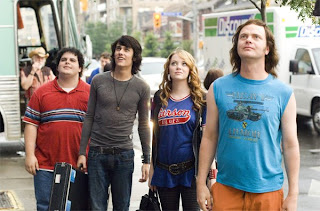How Characters Come Alive
by Kellyann Zuzulo
Every day we hold images in our hands, literally. Androids, iPads, Kindles, and Notebooks. We live in such a visual society that, as a writer, sometimes it's hard to separate an image that originated in my mind and one that I saw somewhere and has become synthesized into my awareness. Is that shocking? Or inevitable.
The generation in which I've been raised has never been without television, film, YouTube (well, I'm not that young; YouTube came later.) And my household was definitely not a "no-tv" house. There were six kids; my Mom needed something to distract us. I'm thinking that this type of visual saturation has effected how I imagine my heroes and villains. Did I see Zubis as an actor playing a role on the SyFy channel before his features drifted from my consciousness onto the page? Maybe. And if it did, would that be a bad thing. Nathaniel Hawthorne probably saw people on the street, albeit garbed in muslin and flannel from collar to ankle, who made their way into his physical descriptions.
Once I wrote my first genie novel, I definitely would assess actors and models as to who would be the best Zubis or the best Bethany. That's normal. Every author eagerly imagines that their novel may someday be a movie or show. As a matter of fact, I just came across images last week of Felix Baumgartner and thought, "He looks like he should live in Jinnistan." I sense a character coming: "corded with muscle" "rugged" "confident fearlessness." I don't yet know who the character will be in the next book, but he'll be there.
I'm sure I created Zubis because I saw a figure in our color- image bombarded world who somehow fit in with my personal Siri-processing mind. Dark hair: check. Broad shoulders: check. Tall: check. Scar: check. Intense expression: check. I know I do this because I've kept some of the images.
The people we see every day inform our characters. Just as interactions we have every day inform our narrative. A writer doesn't write in a vacuum. We incorporate what we see and experience into our stories. We are purveyors of emotion and form. I would recommend that a writer working on a novel should clip and paste into a file those faces and figures that fit our characters. If you have an established, recurring protagonist, then keep track of how they react in various situations. Develop a character profile. And don't be afraid to base those traits on real people. After all, our characters are real when they're in our head. Make them real for your readers.
Pulling these images from the ether is also a good exercise for a book trailer. Even if you never distribute it, a trailer develops your understanding of the world your characters live in. Connecting what is in your head with what can be realized is one more step in competent world building. Most people have Windows Movie Maker on their laptops (or a more-polished Apple program) or a similar program that can easily accommodate your own production. Think it. Make it. Share it. That's what a book is.
Here's my book trailer for your viewing pleasure:
Best Wishes,
Kellyann Zuzulo
THE GENIE IGNITES, now visualized from Boroughs Publishing Group
On Kindle. On Nook.
 |
| Did the character or the image come first? Zubis. |
The generation in which I've been raised has never been without television, film, YouTube (well, I'm not that young; YouTube came later.) And my household was definitely not a "no-tv" house. There were six kids; my Mom needed something to distract us. I'm thinking that this type of visual saturation has effected how I imagine my heroes and villains. Did I see Zubis as an actor playing a role on the SyFy channel before his features drifted from my consciousness onto the page? Maybe. And if it did, would that be a bad thing. Nathaniel Hawthorne probably saw people on the street, albeit garbed in muslin and flannel from collar to ankle, who made their way into his physical descriptions.
 |
| Felix Baumgartner, space jumping phenom, would make a good genie. |
I'm sure I created Zubis because I saw a figure in our color- image bombarded world who somehow fit in with my personal Siri-processing mind. Dark hair: check. Broad shoulders: check. Tall: check. Scar: check. Intense expression: check. I know I do this because I've kept some of the images.
 |
| I think Jason Momoa is a genie. |
 |
| Oded Fehr was an early jinni influence. |
Here's my book trailer for your viewing pleasure:
Best Wishes,
Kellyann Zuzulo
THE GENIE IGNITES, now visualized from Boroughs Publishing Group
On Kindle. On Nook.

Comments
Post a Comment
We would love to hear from you but hope you are a real person and not a spammer. :)